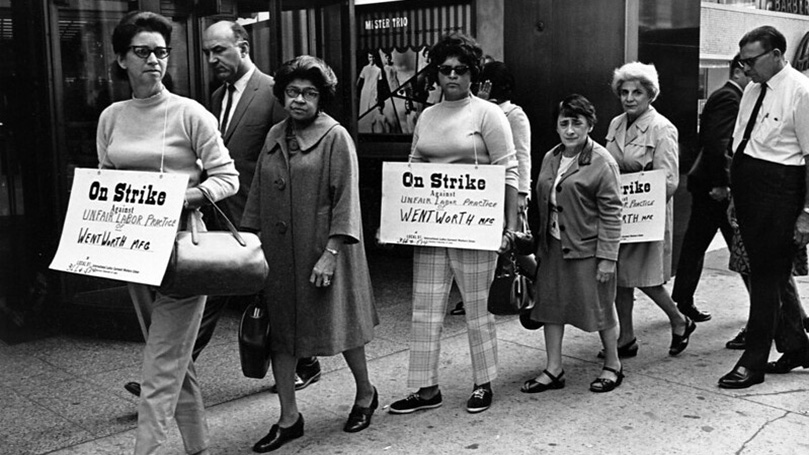
As Women’s History Month began in 2020, the last viable woman candidate for the Democratic nominee for the presidential race exited the election. The primary line-up had begun with the most racially and gender-diverse group of candidates in American history. By early March it had been pared down to an entirely white line-up of candidates, and then an entirely male and white candidate field. While the election has many more months to go, for many voters, there are lingering questions about the limitations that seem to hinder potential female leadership in America.
While we are watching the progress of the election and waiting for the outcome, it is useful to reflect on the changing roles of women in the macrocosm of American society, and how this might be reflected in the future of their role in politics.
• “According to the Department of Labor’s (DOL) Women’s Bureau, 57 percent of women in the United States participate in the labor force. Of these 73 million women, 24.8 million are women of color. As national demographic trends shift, women of color will become a majority among all women and by 2044 will represent the majority of the female workforce” (Advancing Equity for Women and Girls of Color).
• Low-wage ($10.50/hour and lower) care and service jobs are among “the five occupations with the most job growth between 2014 and 2024. Each of these jobs will add at least 300,000 positions in the next ten years; all together they will add 1.9 million jobs, accounting for one-fifth of total job growth” (National Women’s Law Center).
• “Women of color account for 33 percent of the four low-wage, high-growth jobs, compared to 17 percent of the total workforce, meaning their share of these low-wage, high-growth jobs is nearly double their share of the overall workforce. . . . The inequality for foreign-born women is nearly as large—their share of these four jobs (13 percent) is 1.9 times their share of the overall workforce (7 percent)” (National Women’s Law Center).
As of 2016, women were 46.8% of the total workforce. That number is projected to increase to 47.2% by 2024. Despite the expansion of women, especially women of color, in the working class, women are obviously not seeing an equal expansion in earning power, as seen by the facts above.
Membership in a union helps close the wage gap for women’s earnings.
However, with the rise of women in the workforce has come rising female membership in labor unions: “In 2004, 57.4 percent of members were male, while 42.6 percent were female (U.S. Department of Labor 2005). By 2014, women were 45.5 percent, or 6.6 million of 14.6 million union members (U.S. Department of Labor 2015a).”
Membership in a union helps close the wage gap for women’s earnings, with women in union jobs earning 30.9% higher wages than their non-union sisters. This brings a woman union worker closer to the earning power of a male worker, earning around 88 cents on the dollar a man would earn. Women are also entering union leadership, but with barriers to participation.
A study conducted of union women found that among the main barriers to union leadership, women also identified two obstacles: a lack of female leadership at the top of national union organizations to serve as a role model for other potential women union leaders, and also a perception that public authority is not a suitable role for women.
The truth is, women are more likely to vote than men.
Meanwhile, outside union life, women are an expanding political power, but with significant fetters on their potential to exact structural change. The Democrats’ loss of over 1,000 state legislative, gubernatorial, and Congressional seats in the last decade has been bandied about as a data point proving electoral apathy, or a disillusionment with Democratic Party politics. However, destructive electoral suppression policies that affected voter power, especially the votes of working-class women of color, carry much of the blame.
The truth is, women are more likely to vote than men: in 2016, 63.3% of women voted for president, compared to 59.3% of men. In the same year, Black women voted at 63.7%, higher than the national average for women as a whole. In the watershed 2018 midterm elections that elected the highest number of women in American history to the House of Representatives, women as a whole voted 59% for Democratic candidates, with men voting 61% for Republican candidates.
Ninety percent of Black voters cast their ballot for Democratic candidates, with Black women voting 92% for Democratic candidates. Latinx voters voted 69% for Democratic candidates, with Latina women voting 73% for Democratic candidates. White women voted only 49% for Democratic candidates in the 2018 midterms, a slight improvement over their 45% share of the votes for Hillary Clinton in 2016. Overall, Republican support from white women is trending downward. (White men voted 39 percent for Democratic candidates in 2018.)
Because of the electoral structures that favor Republicans, who routinely win less than 50% of the vote, Democratic candidates had to win 53% of the national vote in 2018 to overcome voter suppression and gerrymandering that has been exacerbated since the 2010 census and the 2012 weakening of the Voting Rights Act.
Since women overall tend to vote Democratic, this means that these gerrymandering and suppression policies result in their vote having less power as a group, which then leads to less representation of women in politics. (The number of Republican women in national office is very low and has been reduced even further with each election cycle.) While it could be argued that Republican gerrymandering and voter suppression is just a “gender neutral” grab for power, the combination of these facts makes the disempowering of women voters indisputably a key component to the efforts to hold power.
Since women have gained the right to vote, government social spending has grown exponentially.
When women do get representation and inevitably win political office, the difference is apparent: “Women in Congress sponsor and co-sponsor more bills than men do. . . . Those bills are more likely to benefit women and children or address issues like education, health and poverty.” Female representatives are more likely to sponsor bills in areas like family issues, women’s health, and civil rights.
As for women’s wages, the last time the federal minimum wage was raised was also the last time women’s votes functioned at a similar representational weight to men’s votes, in 2009—prior to Republican redistricting/gerrymandering in 2010—which was also the last year there was a Democratic majority in the House and Senate, until the Democratic Party regained the House in 2018.
Additionally, the history of women’s participation should also be recognized by progressives. Since women have gained the right to vote, government social spending has grown exponentially, and representatives elected by women have adopted more left-leaning policy stances. According to one study, “allowing female suffrage resulted in a more liberal tilt in congressional voting for both houses, and the extent of that shift was mirrored by the increase in turnout due to female suffrage. The effects are quite large.”
Voter suppression weighs most heavily on women of color.
Many racist voter suppression laws are being (continue to be) fought even now, in the hopes that these obstacles will be reduced in time for the November 2020 presidential election. Districts are boldly removing polling places and machines, among other dirty tricks, in brazen displays of interference that seem ripped out of Jim Crow and ante-bellum-era oppression.
Overturning race-based gerrymandering helped increase voter share for people of color in the 2018 elections. However, long lines in several states in the recent Super Tuesday elections in districts with more Black and Latinx voters show that these barriers are still a danger.
Draconian voter suppression measures in several states have the most severe impact on Black and Latinx voters, and with the high number of women voting in these demographics, the damage falls most heavily on women of color attempting to vote—if for no reason other than that they are statistically the ones who are trying most diligently to cast votes.
Special attention must be paid to the outsized role Black women voters play in regional and national elections, in their choice of a leader of any gender. Priority must be given to raising awareness of barriers to voting and funding the legal battles that are fighting them. Male allies can help convince existing political leadership that protection of the vote for women is important.
Women are increasing their numbers in the working class, but until our numbers also translate into our fair share of political power, the entire multi-gender class suffers. We can scarcely claim to have even a liberal democracy, let alone a road to socialism, until the barriers to voting for marginalized Americans are finally removed. Any progressive movement that downplays the role of women, including women of color, in positions of power, including that of the presidency, isn’t worthy of the name.
This Women’s History Month, make it a goal to elevate more women to a place in power for future celebration.
Image: Kheel Center, Creative Commons (BY 2.0).


 Join Now
Join Now